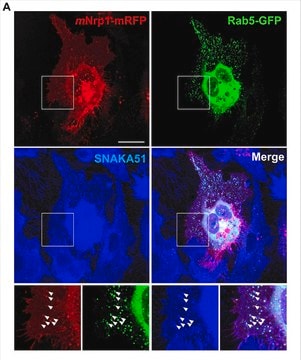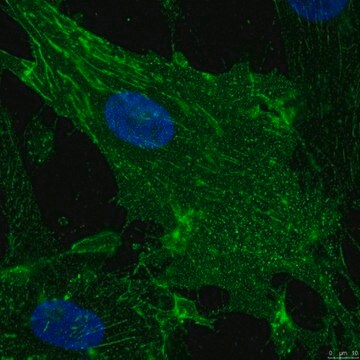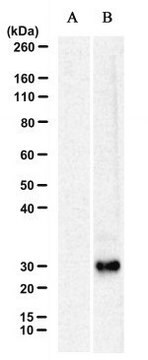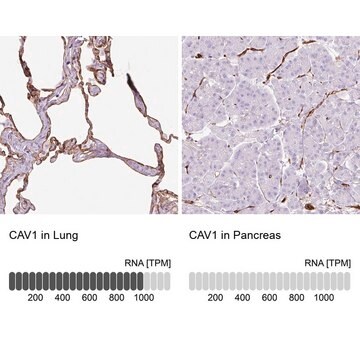推荐产品
生物源
rat
品質等級
抗體表格
purified antibody
抗體產品種類
primary antibodies
無性繁殖
mAb16, monoclonal
物種活性
human
技術
immunocytochemistry: suitable
immunoprecipitation (IP): suitable
inhibition assay: suitable
同型
IgG2aκ
NCBI登錄號
UniProt登錄號
運輸包裝
ambient
目標翻譯後修改
unmodified
基因資訊
human ... ITGA5(3678)
一般說明
Integrin alpha-5 (UniProt: P08648; also known as CD49 antigen-like family member E, Fibronectin receptor subunit alpha, Integrin alpha-F, VLA-5, CD49e) is encoded by the ITGA5 (also known as FNRA) gene (Gene ID: 3678) in human. Integrins are heterodimeric integral membrane proteins composed of an alpha subunit and a beta subunit that function in cell surface adhesion and signaling. Integrin alpha-5 is a single-pass type I membrane protein is expressed on multiple cell types. It contains four calcium binding sites (aa 480-488; 334-342; 401-409; and 465-473). Structurally, it consists of an extracellular domain (aa 4-995), a transmembrane domain (aa 996-1021), and a cytoplasmic domain (aa 1022-1049). When associated with beta 1 subunit it can serve as a receptor for fibronectin and fibrinogen. It recognizes the sequence R-G-D in its ligands. Integrin alpha-5 is also expressed in articular cartilage and plays a role in synovial joint development and in the regulation of chondrocyte survival and matrix degradation in articular cartilage. Membrane fractions obtained from fibroblasts of diabetic animals display significant reduction in integrin alpha-5 levels. (Ref.: Almeida, ME et al., (2016). Mol. Cell. Biochem. 421(1-2); 19-28).
特異性
Clone mAb16 is a rat monoclonal antibody that specifically detects Integrin alpha5 in human cells.
免疫原
Fibronectin receptor purified from human placenta.
應用
Anti-Integrin alpha5 (CD49e), clone mAb16, Cat. No. MABT820, is a rat monoclonal antibody that detects Integrin alpha5 and has been tested for use in Immunocytochemistry, Immunoprecipitation, and Inhibition assays.
Inhibition Analysis: 10 ug/mL from a representative lot prevented HT-1080 cells from adhering to fibronectin coated plates (Courtesy of Dr. Kenneth M. Yamada, M.D., Ph.D., NIDCR, National Institutes of Health, Bethesda, MD USA).
Inhibition Analysis: A representative lot inhibited WI38 fibroblast attachment to fibronectin (Akiyama, S.K., et. al. (1989). J Cell Biol. 109(2):863-75).
Inhibition Analysis: A representative lot inhibited A375-SM cell spreading. (Humphries, J.D., et. al. (2005). J Biol Chem. 280(11):10234-43).
Immunocytochemistry Analysis: A representative lot detected Integrin alpha5 (CD49e) in Immunocytochemistry applications (Akiyama, S.K., et. al. (1989). J Cell Biol. 109(2):863-75).
Immunoprecipitation Analysis: A representative lot immunoprecipitated Integrin alpha5 (CD49e) in Immunoprecipitation applications (Akiyama, S.K., et. al. (1989). J Cell Biol. 109(2):863-75).
Inhibition Analysis: A representative lot inhibited WI38 fibroblast attachment to fibronectin (Akiyama, S.K., et. al. (1989). J Cell Biol. 109(2):863-75).
Inhibition Analysis: A representative lot inhibited A375-SM cell spreading. (Humphries, J.D., et. al. (2005). J Biol Chem. 280(11):10234-43).
Immunocytochemistry Analysis: A representative lot detected Integrin alpha5 (CD49e) in Immunocytochemistry applications (Akiyama, S.K., et. al. (1989). J Cell Biol. 109(2):863-75).
Immunoprecipitation Analysis: A representative lot immunoprecipitated Integrin alpha5 (CD49e) in Immunoprecipitation applications (Akiyama, S.K., et. al. (1989). J Cell Biol. 109(2):863-75).
Research Category
Cell Structure
Cell Structure
品質
Evaluated by Immunocytochemistry in HFF cells.
Immunocytochemistry Analysis: A 1:25 dilution of this antibody detected Integrin alpha5 (CD49e) in human Foreskin Fibroblast (HFF) cells.
Immunocytochemistry Analysis: A 1:25 dilution of this antibody detected Integrin alpha5 (CD49e) in human Foreskin Fibroblast (HFF) cells.
標靶描述
114.54 kDa calculated.
外觀
Protein G purified
Format: Purified
Purified rat monoclonal antibody IgG2a in PBS without azide.
儲存和穩定性
Stable for 1 year at -20°C from date of receipt.
Handling Recommendations: Upon receipt and prior to removing the cap, centrifuge the vial and gently mix the solution. Aliquot into microcentrifuge tubes and store at -20°C. Avoid repeated freeze/thaw cycles, which may damage IgG and affect product performance.
Handling Recommendations: Upon receipt and prior to removing the cap, centrifuge the vial and gently mix the solution. Aliquot into microcentrifuge tubes and store at -20°C. Avoid repeated freeze/thaw cycles, which may damage IgG and affect product performance.
其他說明
Concentration: Please refer to lot specific datasheet.
免責聲明
Unless otherwise stated in our catalog or other company documentation accompanying the product(s), our products are intended for research use only and are not to be used for any other purpose, which includes but is not limited to, unauthorized commercial uses, in vitro diagnostic uses, ex vivo or in vivo therapeutic uses or any type of consumption or application to humans or animals.
Not finding the right product?
Try our 产品选型工具.
儲存類別代碼
12 - Non Combustible Liquids
水污染物質分類(WGK)
WGK 2
Siqi Xiong et al.
Stem cells and development, 29(5), 290-300 (2019-12-20)
Stem cell-based therapy to restore the function of abnormal trabecular meshwork (TM) and decrease intraocular pressure (IOP) provides a novel approach to treat open-angle glaucoma. However, molecular mechanism for stem cells homing and anchoring to the TM remains unclear. This
Michael J McClure et al.
American journal of physiology. Cell physiology, 316(6), C876-C887 (2019-03-21)
Regenerative medicine treatments for severe skeletal muscle injuries are limited, resulting in persistent functional deficits. Clinical options include neglecting the wound with the expectation that fibrosis will develop or using an autologous muscle graft with minimal functional improvement. A regenerative
Brian J Kwee et al.
Proceedings of the National Academy of Sciences of the United States of America, 118(35) (2021-08-28)
Mesenchymal stromal cells (MSCs) are increasingly combined with biomaterials to enhance their therapeutic properties, including their immunosuppressive function. However, clinical trials utilizing MSCs with or without biomaterials have shown limited success, potentially due to their functional heterogeneity across different donors
Shaohe Wang et al.
Cell, 184(14), 3702-3716 (2021-06-17)
Many embryonic organs undergo epithelial morphogenesis to form tree-like hierarchical structures. However, it remains unclear what drives the budding and branching of stratified epithelia, such as in the embryonic salivary gland and pancreas. Here, we performed live-organ imaging of mouse
我们的科学家团队拥有各种研究领域经验,包括生命科学、材料科学、化学合成、色谱、分析及许多其他领域.
联系技术服务部门








